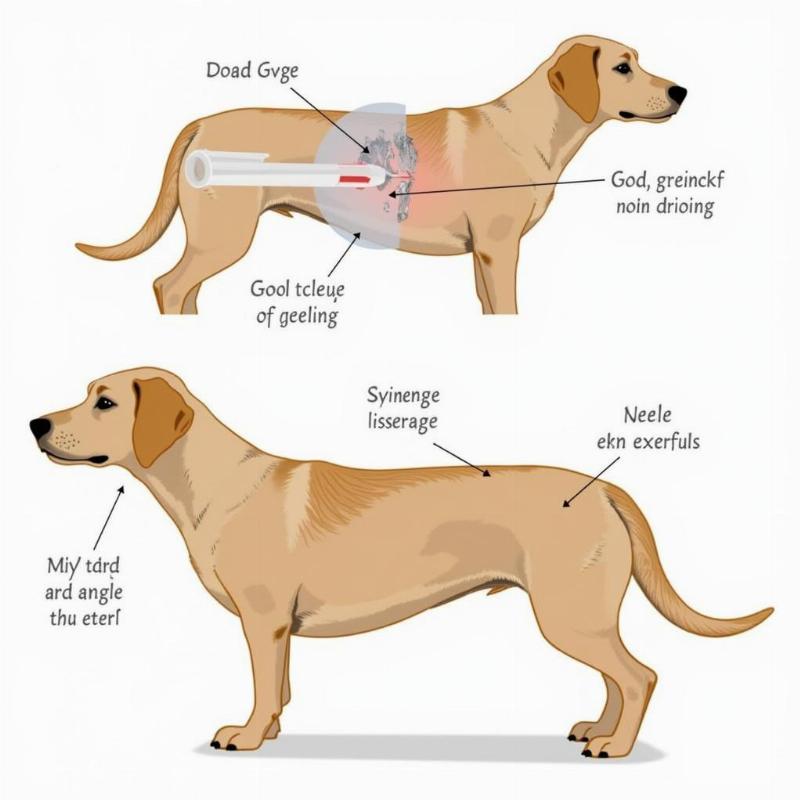Giving an injection to your dog can seem daunting, but with the right knowledge and preparation, it can be a straightforward process. Understanding the proper techniques, safety precautions, and potential complications will empower you to administer medication effectively and comfortably for your furry friend. This comprehensive guide will walk you through the steps involved in giving various types of injections to your dog, addressing common concerns and emphasizing the importance of always consulting with your veterinarian. Remember, this information is for educational purposes and should not replace professional veterinary advice.
Understanding Different Injection Types
Before administering any injection, it’s crucial to understand the type prescribed by your veterinarian. The most common types include subcutaneous (under the skin), intramuscular (into the muscle), and intravenous (into the vein). Each type requires a specific technique and needle size to ensure the medication is delivered correctly and safely. Your vet will provide detailed instructions for the specific medication and injection type your dog needs. Never attempt to give an injection without clear guidance from a veterinarian.
 Subcutaneous injection for dogs
Subcutaneous injection for dogs
Gathering Your Supplies
Having everything readily available will make the process smoother and less stressful for both you and your dog. You’ll need the prescribed medication, the appropriate syringes and needles (as instructed by your vet), alcohol wipes for sterilization, and a small treat to reward your brave companion. It’s also a good idea to have a second person assist in holding and comforting your dog, especially if they are anxious or prone to movement.
Step-by-Step Guide to Subcutaneous Injections
Subcutaneous injections are the most common type given at home. Follow these steps carefully:
- Prepare the medication and syringe: Draw the correct dosage into the syringe as instructed by your veterinarian.
- Choose an injection site: The scruff (loose skin on the back of the neck) is the preferred location. Gently lift the skin to create a “tent.”
- Insert the needle: Insert the needle at a 45-degree angle into the tented skin.
- Aspirate: Gently pull back on the plunger to check for blood. If you see blood, withdraw the needle and try again at a slightly different location.
- Inject the medication: Slowly depress the plunger to administer the medication.
- Withdraw the needle: Remove the needle and gently massage the injection site.
- Reward your dog: Offer a treat and praise to create a positive association with the experience.
Step-by-Step Guide to Intramuscular Injections
Intramuscular injections require more precision and are typically administered by a veterinarian. However, if your vet has instructed you to give an intramuscular injection, follow their specific guidance meticulously. These injections usually target the large muscle groups in the hind leg.
Important Considerations and Potential Complications
Always follow your veterinarian’s instructions precisely. Incorrect administration can lead to complications such as pain, infection, abscess formation, or ineffective treatment. Never reuse needles, and dispose of used sharps safely. Observe your dog for any adverse reactions after the injection, such as swelling, redness, or behavioral changes. Report any concerns to your vet immediately.
Conclusion
Learning how to give an injection to your dog can be a valuable skill, allowing you to provide essential care at home. Remember to prioritize your dog’s comfort and safety by following your veterinarian’s instructions meticulously. Never hesitate to contact your vet if you have any questions or concerns. With careful preparation and practice, you can confidently administer injections and contribute to your dog’s overall well-being.
FAQs
- Can I give my dog an injection without consulting a vet? No, never administer any injection to your dog without explicit instructions from your veterinarian.
- What if my dog yelps during the injection? This can happen, but it doesn’t always mean something is wrong. Try to remain calm and continue administering the medication slowly.
- What should I do if I accidentally stick myself with the needle? Wash the area thoroughly with soap and water and contact your doctor immediately.
- How do I dispose of used needles? Place used needles in a puncture-resistant container, such as a sharps container, and dispose of it according to local regulations.
- What if my dog develops a lump at the injection site? A small lump is sometimes normal, but if it persists or becomes larger, contact your veterinarian.
- Can all medications be given via injection? No, some medications are formulated specifically for oral administration or other routes.
- What if my dog refuses to let me give the injection? If your dog is extremely resistant, it’s best to consult with your veterinarian for alternative methods or professional assistance.
Related Articles
- how to give dog injection
- how to give subcutaneous injection to a dog
- dog lump after rabies shot
- butorphanol for dogs dosage per kg
Beautdogs.us is your premier online resource for comprehensive dog care information, breed guides, and top-quality products. Whether you’re a new dog owner or a seasoned expert, Beautdogs.us provides expert advice and valuable resources to help you navigate every aspect of dog ownership. From health and nutrition to training and grooming, we’re dedicated to empowering you with the knowledge you need to provide the best possible care for your furry companion. Contact us today for personalized guidance and discover a world of valuable resources for your beloved pet. Email: [email protected], Phone: +1 501-555-7529 or visit us at Beautdogs.us.